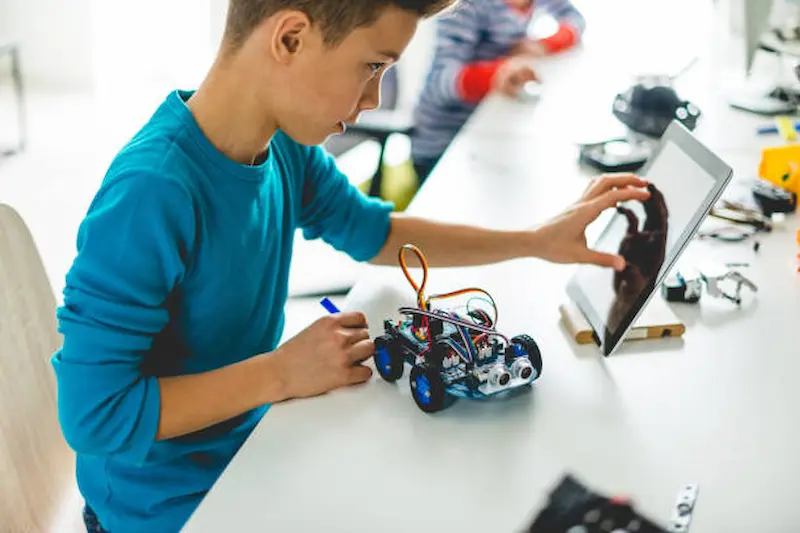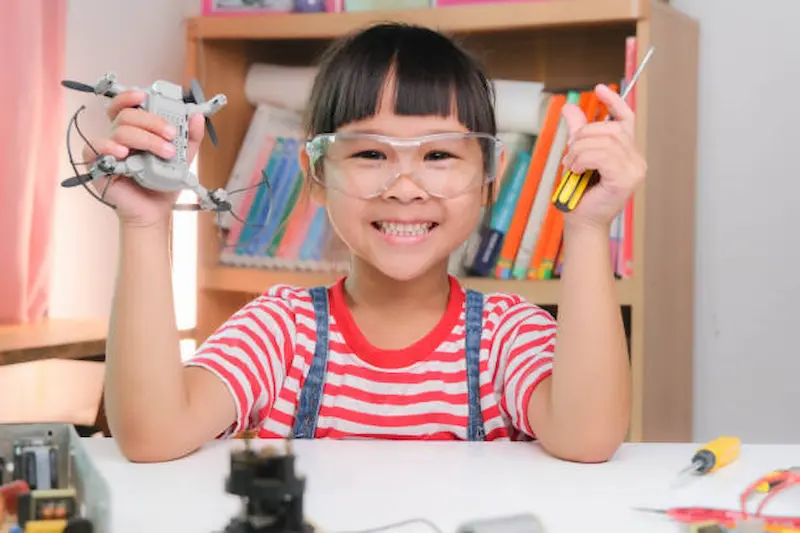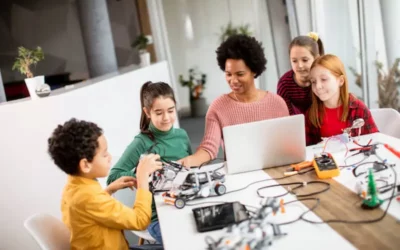Robotics lessons for kids involve hands-on learning experiences that teach fundamental programming and engineering concepts. These lessons are important because they help children develop problem-solving abilities, increase logical thinking, and inspire creativity. Robots can help youngsters create a firm foundation in STEM topics, preparing them for future technological problems and possibilities.
In this article, you may learn about the relevance of Robotics Lessons for Kids. These hands-on experiences not only teach fundamental programming and engineering concepts, but also help to build problem-solving skills, logical thinking, and creativity. Robots introduced to children at a young age may create a strong foundation in STEM topics, preparing them for future technological problems and opportunities.
Table of contents
- Benefits of Robotics for Kids
- Getting Started with Robotics Education
- Popular Robotics Platforms for Kids
- Integrating Robotics into the Curriculum
- Interactive Learning: Coding for Kids
- Real-World Applications of Kids’ Robotics
- Overcoming Challenges in Kids’ Robotics Education
- Parental Involvement and Support
- Conclusion
- Frequently Asked Questions ( FAQs )
Benefits of Robotics for Kids

A. Enhancing Critical Thinking Skills:
- Robotics challenges children to think critically, analyze problems, and develop logical solutions.
- Engaging in programming and troubleshooting exercises cultivates a structured approach to problem-solving.
- Through the process of designing and refining their robots, kids not only delve into the exciting realms of engineering and programming but also cultivate critical thinking skills.
- The integration of “critical thinking skills for kids” into this hands-on experience with robotics ensures that the learning extends beyond technical aspects, encouraging young minds to analyze, synthesize, and apply their knowledge in creative and thoughtful ways.
B. Fostering Creativity and Innovation:
- Building and designing robots stimulates creativity and innovation among kids.
- The process of envisioning, creating, and refining robot projects nurtures a sense of curiosity and originality.
- Robotics allows children to explore unconventional ideas, fostering a mindset that embraces innovation and out-of-the-box thinking.
C. Building Problem-Solving Abilities:
- Robotics education encourages kids to tackle real-world problems through hands-on application of scientific and mathematical concepts.
- Debugging and optimizing robot functionalities provide practical problem-solving experiences.
- As children encounter challenges in building and programming, they develop resilience and resourcefulness, key attributes in addressing complex issues.
D. Instilling Teamwork and Collaboration:
- Collaborative robotics projects teach children the importance of teamwork.
- Working in groups enhances communication skills and promotes collaborative problem-solving, preparing kids for future collaborative endeavors. Engaging in activities for kids within these group settings further amplifies the learning experience, fostering teamwork, creativity, and social development.
- Kids learn to appreciate diverse perspectives and leverage the strengths of each team member, fostering a collaborative spirit that extends beyond the realm of robotics.
Getting Started with Robotics Education

A. Age-Appropriate Robotics Kits:
Preschoolers (Ages 3-5):
- Introductory kits for preschoolers focus on motor skills and basic concepts using large, colorful building blocks.
- These kits often incorporate simple programming interfaces, introducing the foundations of logical thinking through interactive play.
Elementary School (Ages 6-10):
- Elementary kits introduce more complex building elements and basic coding concepts.
- Designed to spark curiosity, these kits often include guided projects to encourage creativity while developing fundamental robotics skills.
Middle School (Ages 11-14):
- Advanced kits for middle schoolers delve into more sophisticated programming and construction challenges.
- These kits often align with STEM curricula, offering a deeper understanding of robotics principles and preparing students for more complex projects.
B. Selecting the Right Robotics Platform:
- Choose a platform that aligns with educational goals and the age group’s skill level.
- Consider platforms that allow for scalability, enabling students to progress from basic to advanced robotics projects seamlessly.
C. Creating a Safe and Engaging Learning Environment:
- Ensure the learning space is well-equipped with safety features for handling robotics kits.
- Encourage collaboration and creativity by arranging the workspace to facilitate group activities, promoting a dynamic and supportive learning atmosphere.
Popular Robotics Platforms for Kids

- LEGO Mindstorms, a versatile kit providing an engaging introduction to programming and engineering, is an excellent choice for kids interested in robotics. In terms of Overview, Mindstorms boasts a programmable brick, motors, sensors, and a diverse range of LEGO elements. Key Features include the ability for kids to build and code their robots, fostering creativity and problem-solving skills. The inclusion of “LEGO robotics for kids” in this kit adds an extra layer of excitement, making it an ideal platform for young enthusiasts to delve into the world of robotics. Sample Projects are readily available, offering pre-designed creations that inspire and enhance technical proficiency.
- Dash and Dot Robots, on the other hand, offer a user-friendly Introduction to robotics, making coding accessible through interactive play. The Educational Value lies in promoting logical thinking and coding skills, deepening a child’s understanding of algorithms and problem-solving. The robots provide a range of Fun Activities, including storytelling and music, ensuring that learning is not only educational but also enjoyable, thereby nurturing a passion for STEM fields.
Integrating Robotics into the Curriculum

A. Robotics in STEM Education:
- Linking Robotics to Science:
- Integrating robotics in science classes allows students to apply scientific principles through hands-on experimentation.
- Robotics projects provide a tangible context for exploring physics, engineering, and biology, fostering a deeper understanding of scientific concepts.
- Mathematics and Coding Connections:
- Robotics serves as a practical application of mathematics, reinforcing concepts like geometry and algebra.
- Coding, an integral part of robotics, strengthens mathematical thinking by translating abstract ideas into concrete actions.
B. Robotics in Arts and Creativity:
- Incorporating Design and Aesthetics:
- Robotics merges with arts by emphasising design aesthetics, encouraging students to create visually appealing and functional robots.
- The integration of design principles enhances the artistic aspect of STEM education, making it more holistic.
2. Storytelling with Robots:
- Robotics becomes a medium for storytelling, combining creativity and technology.
- Students can explore narrative elements by programming robots to act out stories, fostering imaginative thinking and linking technology with the expressive arts.
Interactive Learning: Coding for Kids

A. Basics of Coding:
- Introduction to Coding Languages for Kids:
- Coding education for kids typically begins with accessible languages like Scratch or Blockly, introducing fundamental concepts in a visually intuitive manner. Platforms like Scratch coding for kids provide a user-friendly, block-based programming interface that allows young learners to create interactive stories, games, and animations.
- These platforms provide a gentle entry into programming, allowing kids to grasp coding fundamentals in a fun and interactive environment.
- Visual Programming for Young Minds:
- Visual programming interfaces use block-based coding, enabling even the youngest minds to create code by assembling graphical blocks.
- This approach simplifies complex coding concepts, making it easier for kids to understand and experiment with programming logic.
B. Coding Challenges and Games:
- Gamifying Learning:
- Coding challenges and games are designed to gamify the learning process, making it enjoyable and engaging for kids. These interactive experiences, often integrated into educational platforms, utilize elements of play to teach coding concepts in a fun and accessible way. Learning games for kids, specifically tailored to their age and skill level, provide a dynamic environment where they can experiment, make mistakes, and learn from them.
- By incorporating elements of competition and achievement, these activities motivate children to actively participate and progress in their coding skills.
- Engaging Challenges for Different Age Groups:
- Tailored coding challenges cater to various age groups, ensuring that the difficulty level aligns with the child cognitive development.
- These challenges not only teach coding skills but also enhance problem-solving abilities, critical thinking, and creativity, fostering a well-rounded educational experience.
Real-World Applications of Kids’ Robotics

A. Showcasing Inspiring Examples:
Robotics in Medicine:
- Kids’ robotics extends beyond the classroom with impactful applications in medicine. Simple robotic devices aid in surgeries, offering precision and minimizing invasiveness.
- Understanding robotics in medicine introduces children to the potential of technology in improving healthcare, inspiring future innovators in the medical field.
Robotics in Environmental Conservation:
- Kids’ robotics contributes to environmental stewardship through applications like robotic drones monitoring ecosystems and assisting in conservation efforts.
- Exploring robotics in environmental contexts empowers children to connect technology with real-world challenges, fostering a sense of responsibility and environmental awareness.
Overcoming Challenges in Kids’ Robotics Education
Overcoming challenges in kids’ robotics education involves addressing barriers to effective learning, with a focus on solutions such as robotics courses for kids. Challenges may include the need for simplified programming interfaces, ensuring age-appropriate content, and fostering inclusivity. Robotics courses for kids are designed to provide structured and engaging learning experiences, catering to their developmental stages. In addition to dedicated courses, providing accessible resources, teacher training, and collaborative learning environments can enhance engagement and make robotics education more accessible. Tailoring educational approaches to diverse learning styles helps overcome hurdles, ensuring that kids find robotics education not only enriching but also accessible, fostering a lifelong interest in technology and problem-solving.
Parental Involvement and Support

Parental involvement and support play a crucial role in a child’s educational journey, highlighting the significance of positive parenting. Engaged parents contribute significantly to academic success by fostering a positive learning environment. Through positive parenting practices, such as participating in their child’s education, parents can better understand and support their learning needs, reinforcing the importance of education in the child’s life.
Regular communication with teachers, active involvement in school activities, and the creation of a conducive home environment all contribute to a child’s overall educational experience and success.
Conclusion
Robotics lessons for kids offer invaluable benefits by introducing them to the exciting world of technology. These hands-on experiences not only teach programming and engineering concepts but also foster critical thinking, problem-solving, and teamwork skills. Additionally, kids gain a deeper understanding of science and mathematics in a practical context. As technology continues to shape our world, these early lessons in robotics empower children with the skills and confidence needed for future success in STEM fields.
Elevate your child’s learning journey with BrightChamps, the leading EdTech company offering a transformative blend of robotics, financial education, and coding courses.
To get your hands on more such articles, educational content, and free resources on coding for kids, robotics courses, game development, etc., check out the BrightCHAMPS Blog Page now!
Frequently Asked Questions ( FAQs )
A1. Introducing robotics to kids is suitable from around 5 years old, but age-appropriate kits exist for various developmental stages.
Q2. How can I choose the right robotics kit for my child’s age group?
A2. Choose a robotics kit based on your child’s age and skill level, ensuring it aligns with their ability to understand and enjoy the learning process.
Q3. Are there any safety concerns with robotics activities for kids?
A3. While robotics activities are generally safe, supervision is advised, and age-appropriate kits help mitigate any potential safety concerns.
Q4. What skills can my child gain from learning robotics?
A4. Learning robotics enhances problem-solving, critical thinking, and teamwork skills, fostering a foundation in STEM (Science, Technology, Engineering, and Mathematics) disciplines.
Q5. How can I support my child’s interest in robotics at home?
A5. Support your child’s interest in robotics by providing hands-on activities, encouraging exploration, and participating in the learning process together.
Q6. Are there any online resources for additional learning?
A6. Numerous online resources, including tutorials, forums, and educational platforms, offer additional learning opportunities for children interested in robotics.


 We are an army of educators and passionate learners from BrightChamps family, committed to providing free learning resources to kids, parents & students.
We are an army of educators and passionate learners from BrightChamps family, committed to providing free learning resources to kids, parents & students.














